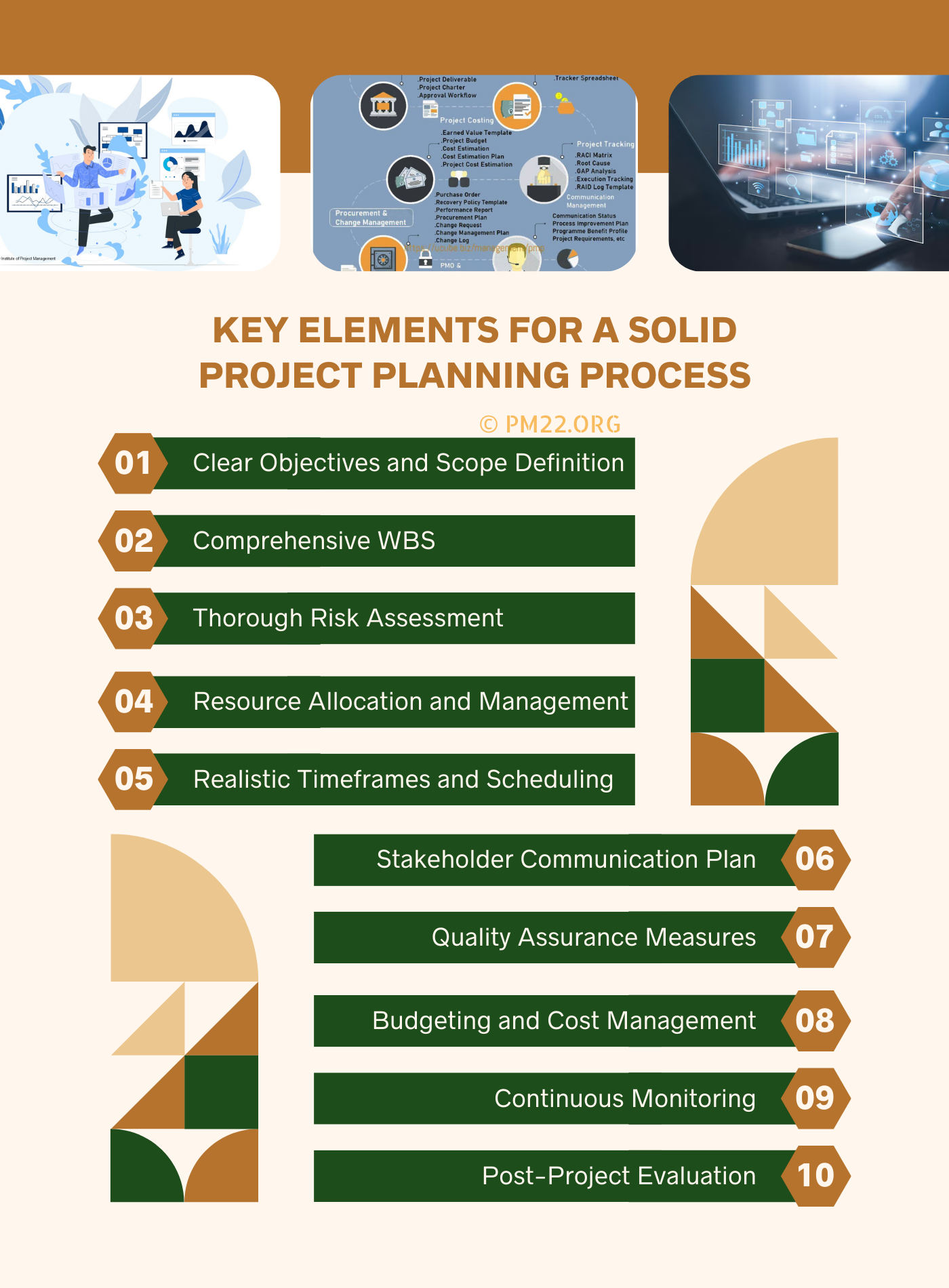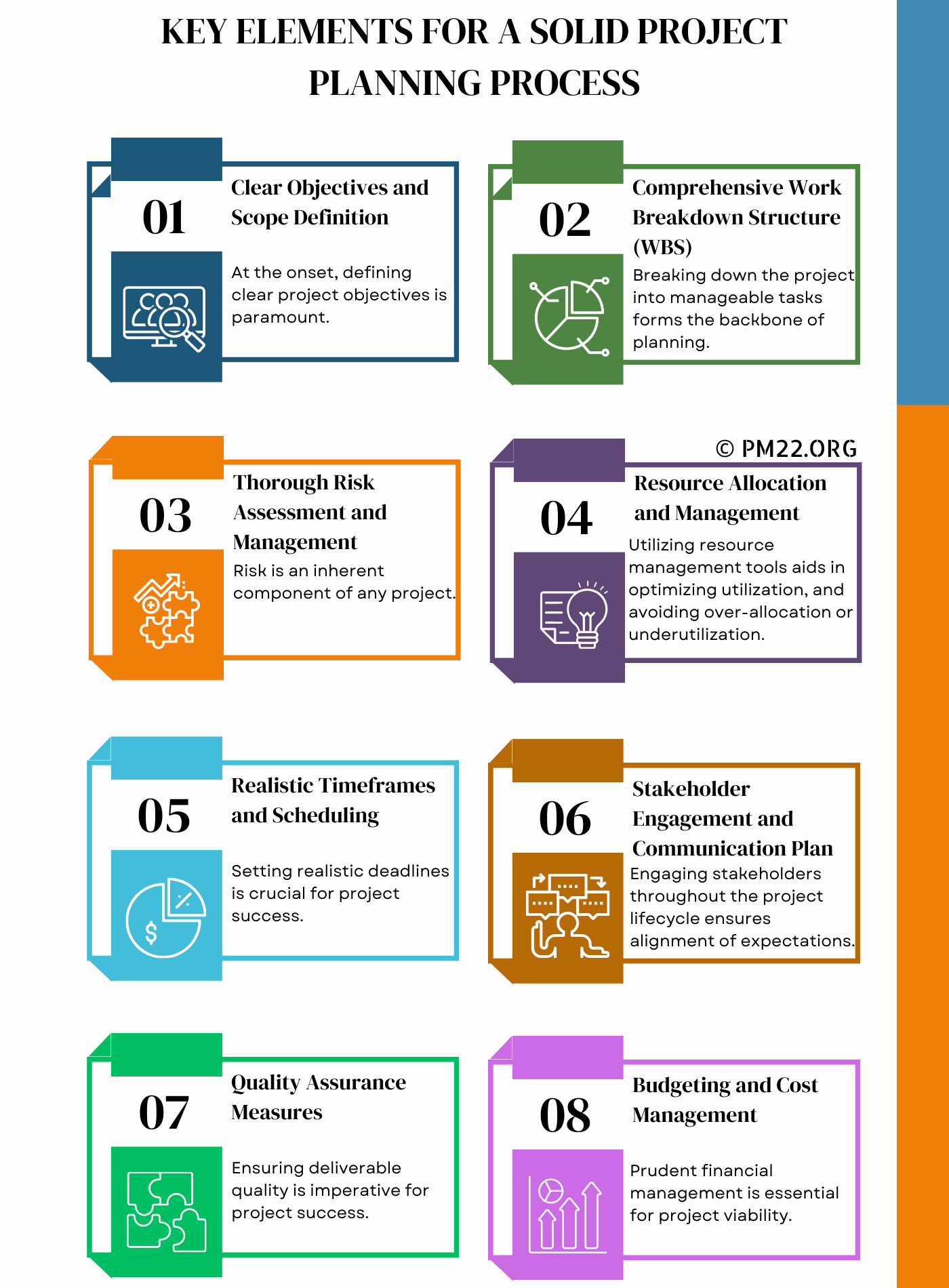 In the dynamic realm of project management, success hinges upon meticulous planning. Every project, whether big or small, demands a structured approach to ensure its timely completion and attainment of objectives. A robust project planning process serves as the blueprint guiding teams through the intricacies of execution, mitigating risks, and fostering collaboration. Here, we delve into the essential elements that constitute a solid project planning process.
In the dynamic realm of project management, success hinges upon meticulous planning. Every project, whether big or small, demands a structured approach to ensure its timely completion and attainment of objectives. A robust project planning process serves as the blueprint guiding teams through the intricacies of execution, mitigating risks, and fostering collaboration. Here, we delve into the essential elements that constitute a solid project planning process.
Clear Objectives and Scope Definition: At the onset, defining clear project objectives is paramount. These objectives should be specific, measurable, achievable, relevant, and time-bound (SMART). Furthermore, outlining the project’s scope delineates the boundaries of work, preventing scope creep and ensuring alignment with stakeholders’ expectations.
Comprehensive Work Breakdown Structure (WBS): Breaking down the project into manageable tasks forms the backbone of planning. A well-structured WBS categorizes activities hierarchically, facilitating resource allocation, scheduling, and monitoring progress. Each task should be clearly defined, with dependencies identified to streamline workflow.
Thorough Risk Assessment and Management: Risk is an inherent component of any project. Identifying potential risks early allows teams to develop mitigation strategies and contingency plans. From technical challenges to resource constraints, a comprehensive risk management plan ensures proactive responses to unforeseen circumstances, safeguarding project timelines and budgets.
CLICK HERE TO DOWNLOAD 300+ PROJECT MANAGEMENT TEMPLATES & DOCUMENTS IN EXCEL
Resource Allocation and Management: Effective resource allocation entails identifying and assigning the right talent, tools, and materials to each task. Utilizing resource management tools aids in optimizing utilization and avoiding over-allocation or underutilization. Additionally, fostering open communication channels enables swift resolution of resource-related issues, fostering synergy among team members.
Realistic Timeframes and Scheduling: Setting realistic deadlines is crucial for project success. Utilizing techniques such as Critical Path Method (CPM) or Program Evaluation and Review Technique (PERT) aids in developing accurate schedules. However, flexibility is key, allowing for adjustments to accommodate unforeseen delays or changes in project scope.
Stakeholder Engagement and Communication Plan: Engaging stakeholders throughout the project lifecycle ensures alignment of expectations and promotes transparency. Establishing a robust communication plan facilitates regular updates, addressing concerns, and garnering feedback. Effective communication channels, whether through meetings, status reports, or project management software, foster collaboration and accountability.
Quality Assurance Measures: Ensuring deliverable quality is imperative for project success. Implementing quality assurance measures at each stage of the project lifecycle mitigates risks of defects or errors. Incorporating quality checkpoints, peer reviews, and testing protocols ensures adherence to standards and client requirements.
Budgeting and Cost Management: Prudent financial management is essential for project viability. Developing a detailed budget, and accounting for all expenses, ensures financial transparency and accountability. Tracking expenditures against the budget enables timely adjustments, preventing cost overruns and maximizing resource utilization.
Continuous Monitoring and Performance Evaluation: Regular monitoring of project progress allows for the timely identification of deviations from the plan. Utilizing Key Performance Indicators (KPIs) aids in gauging performance against objectives and benchmarks. Periodic performance evaluations enable course correction, ensuring project alignment with strategic goals.
CLICK HERE TO DOWNLOAD 300+ PROJECT MANAGEMENT TEMPLATES & DOCUMENTS IN EXCEL
Post-Project Evaluation and Lessons Learned: Upon project completion, conducting a thorough post-mortem analysis provides invaluable insights for future endeavors. Identifying successes, challenges, and areas for improvement fosters organizational learning and continuous improvement. Documenting lessons learned ensures knowledge retention, enhancing future project outcomes.
In conclusion, a solid project planning process is the cornerstone of project success. By incorporating these key elements – from clear objective setting to post-project evaluation – project managers can navigate the complexities of execution with confidence and finesse. Embracing a structured approach fosters collaboration, mitigates risks, and ultimately, paves the path to triumph in the ever-evolving landscape of project management. Top of Form
